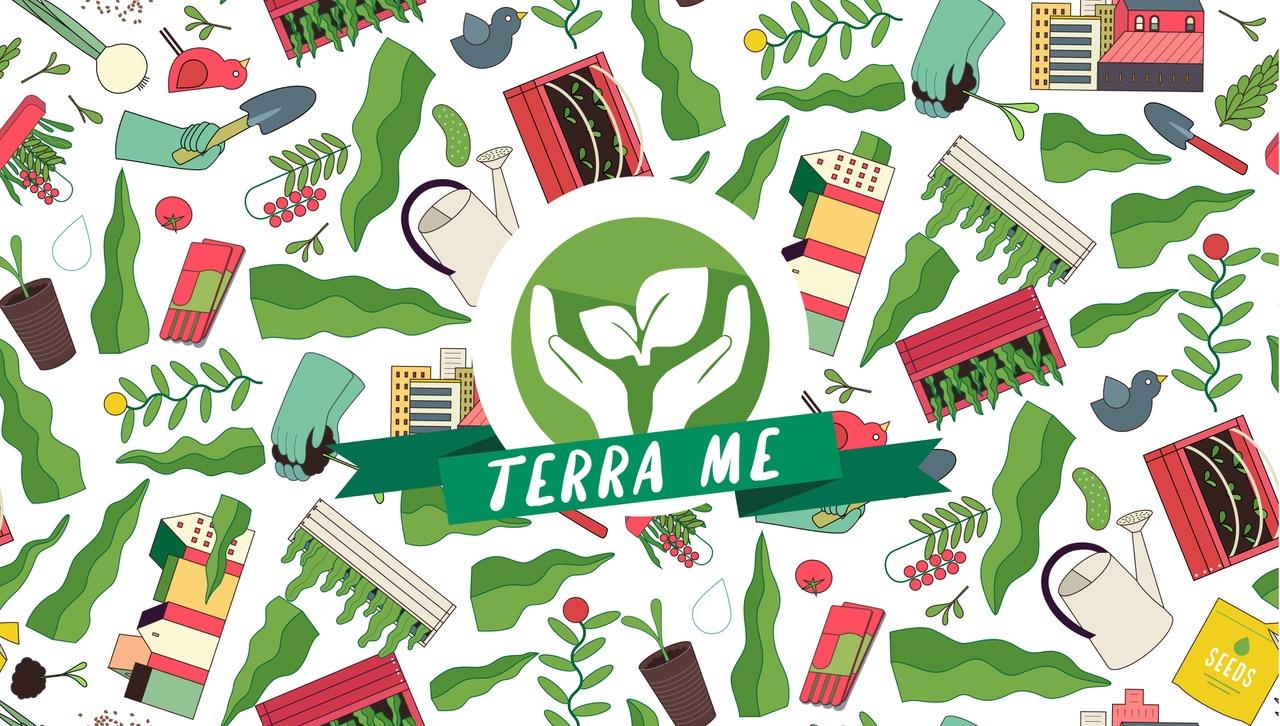SERVICES:
Creative ideation
Research, Testing, UI, Illustration, Content strategy, UX, Copywriting, Business planning, Coding, Prototyping, Marketing
DATE:
2018
SECTOR:
Entertainment & Recreational
BRIEF
TERRA ME is the brainchild of myself and a friend Angie Eckstein who both share a deep passion for gardening and believe that we can sustain the earth one plant at a time.
CHALLANGE
Angie and I were sitting down over a cup of coffee when I shared with her my frustration on keeping my plants alive and she wholeheartedly agreed and added that she finds it difficult to find accurate and easy to understand plant care information on one consistent platform and so, the creation of TERRA ME began.
SOLUTION
We wanted to validate our idea that others might benefit from a solution that inspires users to overcome barriers, such as lack of time and knowledge, by providing easy-to-understand information that will help gardeners accomplish their gardening goals and connect them back to nature. In order to arrive at our solution we approached the problem from a design thinking perspective. Ultimately we landed on a solution that manifested into a PWA (progressive web application).
DESIGN PROCESS
1. Empathize. To arrive at the perfect solution we started talking to potential users and researching their needs. We went to garden centers, friends and family and did field research. We interviewed gardeners and conducted surveys to learn about their gardening pain points and goals.
2. Define. To define the problem we analyzed and synthesized our observations and defined our core user needs.
3. Ideate. We then started ideating and challenging existing assumptions and creating new ideas.
4. Prototype. We began to prototype iteratively and started to create solutions informed by user pain points and guided by our vision of TERRA ME and user feedback.
5. Test. Lastly, we tested our solution and tried it with users. We recruited and planned detailed testing scenarios with potential users to refine and optimize TERRA ME.
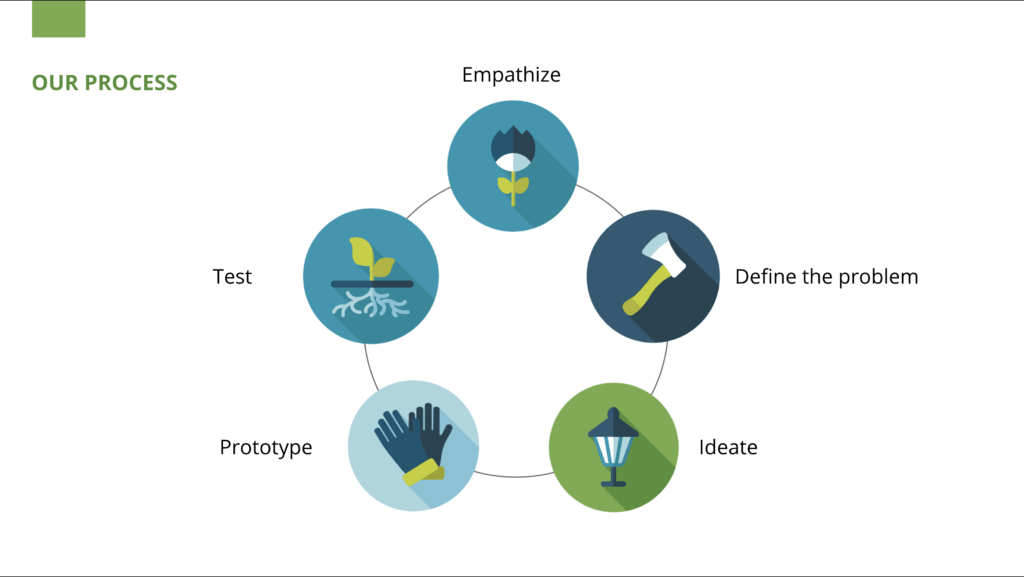
RESEARCH
The research was a continues process through the entire project. We conducted user interviews, surveys, and guerrilla testing to identify our user needs and pain points.
The main goals of the research were to pinpoint:
1. Are people looking for a disruptive tech-based plant care solution?
2. Identify our most profitable targeted users?
3. What are their plant care pains and gains?
4. What features do people want in a plant care platform?
THE MAIN GOALS WERE TO PINPOINT:
1. Are people looking for a disruptive tech-based plant care solution?
2. Identify our most profitable targeted users?
3. What are their plant care pains and gains?
4. What features do people want in a plant care platform?
USER INTERVIEWS
We conducted a series of interviews with gardeners of varying skill level. We learned about our users’ pain points, what they have tried when it comes to plant care, and ideas for improving existing solutions.
SURVEYS
We also conducted a survey to find out more about our user needs. We developed the survey using Google Forms. We posted the survey to my Facebook network. A total of 41 people accessed the survey. Since we wanted to survey only people who currently take care of plants, nine people screened out as they did not currently care for a plant. A total of 32 people completed the survey.
In the survey we asked about plant care experience, pain points, branding, and internet familiarity. We learned what users like and dislike about using the web for plant care information. We also learned that of the 32 respondents, none of them used a plant care app. These findings informed our decision to design a responsive website instead of an app.
GUERRILLA TESTING
From our research we started to ideate potential solutions. Because we had so many solutions, we interviewed users on the streets of Barcelona to help us narrow down key problems for gardeners. The goals of the testing were to understand:
1. How much do people enjoy plant care and gardening?
2. What are their plant care pains and gains?
3. What features do people want in a plant care website?
We intercepted three people on Friday evening after work. Interviews were conducted in English and Spanish. The testing helped us further develop our personas and narrow down a long list of possible features to those features most important to our users.
ANALYZE AND SYNTHESISE
After the interviews and surveys, we reviewed our notes and recordings to identify themes and user pain points. I wrote each pain point on a post-it and then clustered each pain point under a theme. Four themes emerged including, “Gardening Problems”, “Why people garden”, “How people get gardening information”, and “Problems finding gardening information”. From these themes, we narrowed down our findings into four pain points. The quotes from our interview participants help shed light on each pain point.
USER PAIN POINTS
1.Users find plant care information can be overwhelming.
“I AM HUNGRY FOR SPECIFIC AND SIMPLE INFORMATION AND LOOKING FOR GUIDANCE.”
2. Users can’t easily find plant care information by searching the internet.
“I HAVE BEEN GARDENING FOR MANY YEARS NOW AND HAVE HAD GREAT SUCCESS WITH MY PLANTS. HOWEVER, I STILL SPEND A LOT OF TIME SEEKING INFORMATION BY SEARCHING THE WEB, GOING TO GARDEN CENTERS, AND TALKING TO FRIENDS.”
3. Users forget to care for their plants, specifically users often forget to water their plants.
“I AM PULLED IN SO MANY DIFFERENT DIRECTIONS WITH FAMILY AND WORK THAT I OFTEN FORGET OR DON’T HAVE TIME TO TAKE CARE OF MY PLANTS. THIS IS A DILEMMA FOR ME BECAUSE I ENJOY MY PLANTS AND ENTERTAINING IN MY GARDEN BUT OFTEN LACK THE RESOURCES TO DO SO.”
4. Users don’t often know what is wrong with their plants.
“I HAVE BEEN GARDENING FOR 4 YEARS, BUT STILL HAVE MIXED SUCCESS WITH GARDENING AND DO NOT KNOW WHY.”
PERSONAS
Using our research findings, we identified and created personas for TERRA ME including the busy individual, the hobbyist, the family, and the recurrent struggler. However, we knew that the TERRA ME community would function best with users who are seeking plant care information as well as users who are able to provide plant care information. That is why we identified the busy individual and hobbyist as our primary personas.

PROTOTYPING
With our research, brand book and personas in place, we began to prototype solutions beginning with paper prototypes. We created paper wireframes and used Post Its to create mock interactive elements for each screen. To select an item on the paper screen, the user placed a Post It on top of the UI element. The Post It served as a reference for documenting the path the user took through the screens after the testing.
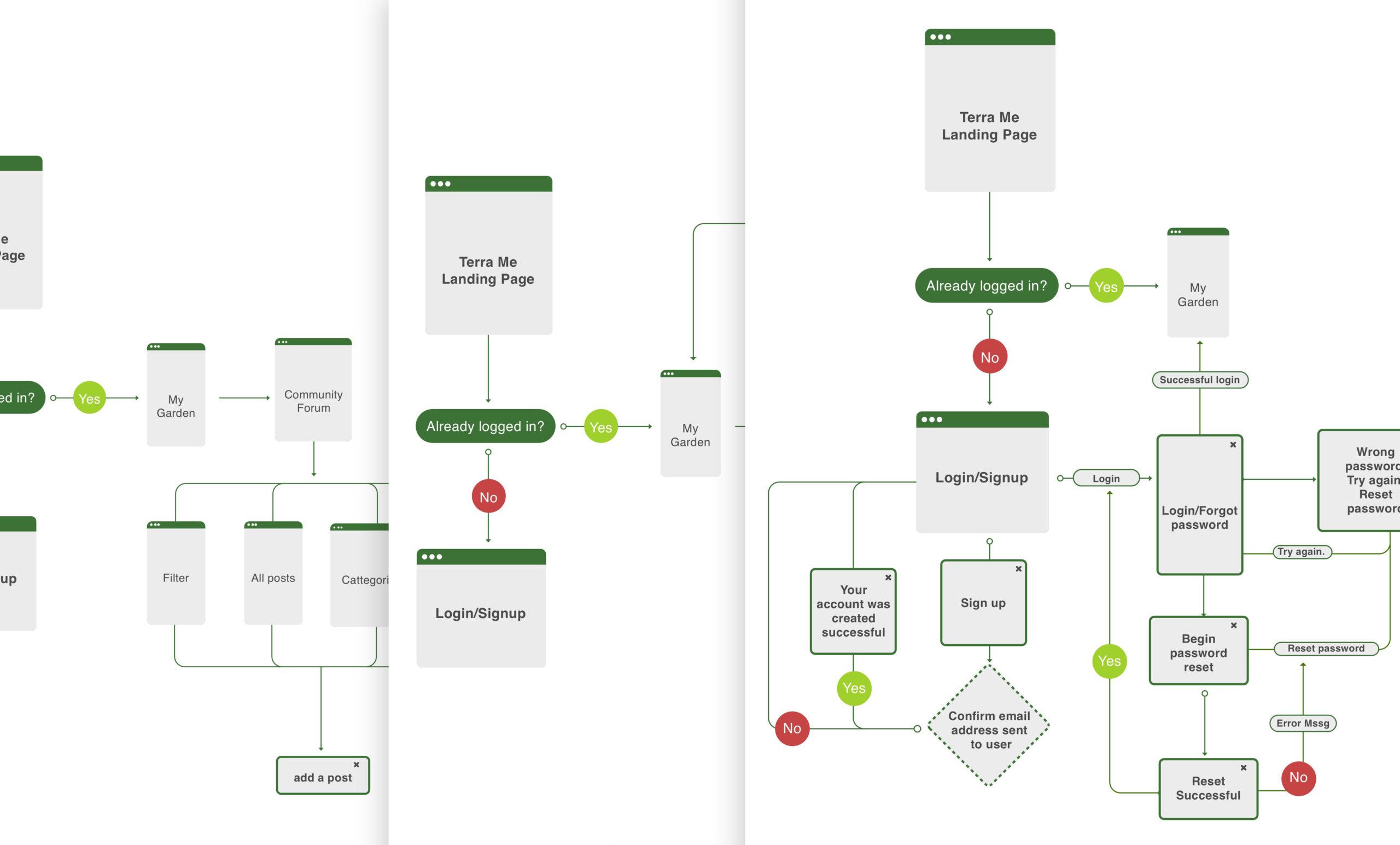
TESTING
We tested the paper prototype with seven participants. Users were asked to search for a plant and add it to their garden. From the prototype, we were able to validate that the idea was useful, learn common paths that users took to perform the tasks, and learn about features and wording that would be helpful for the users.
DESIGN PRINCIPLES
We began by designing and implementing design principles. Then moved on to user flows, user journeys, and wireframes. In addition to low-fi and mid-fi prototypes. After each round of design, we would test with users and iterate the designs.
BRANDING
Below you can browse through the entire brand book that TERRA ME is built on. In the book, we cover brand strategy, brand identity, and content strategy.
HIGHT FIDELITY DESIGNS
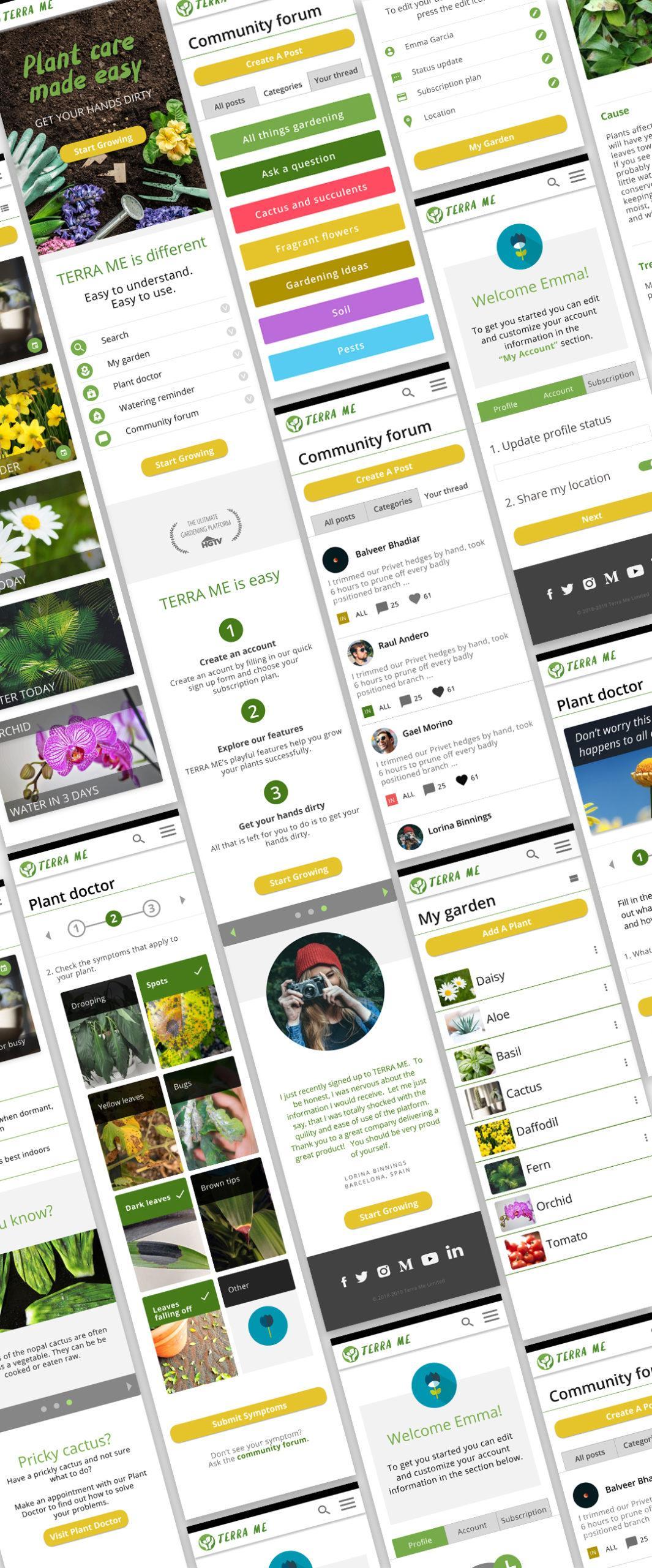
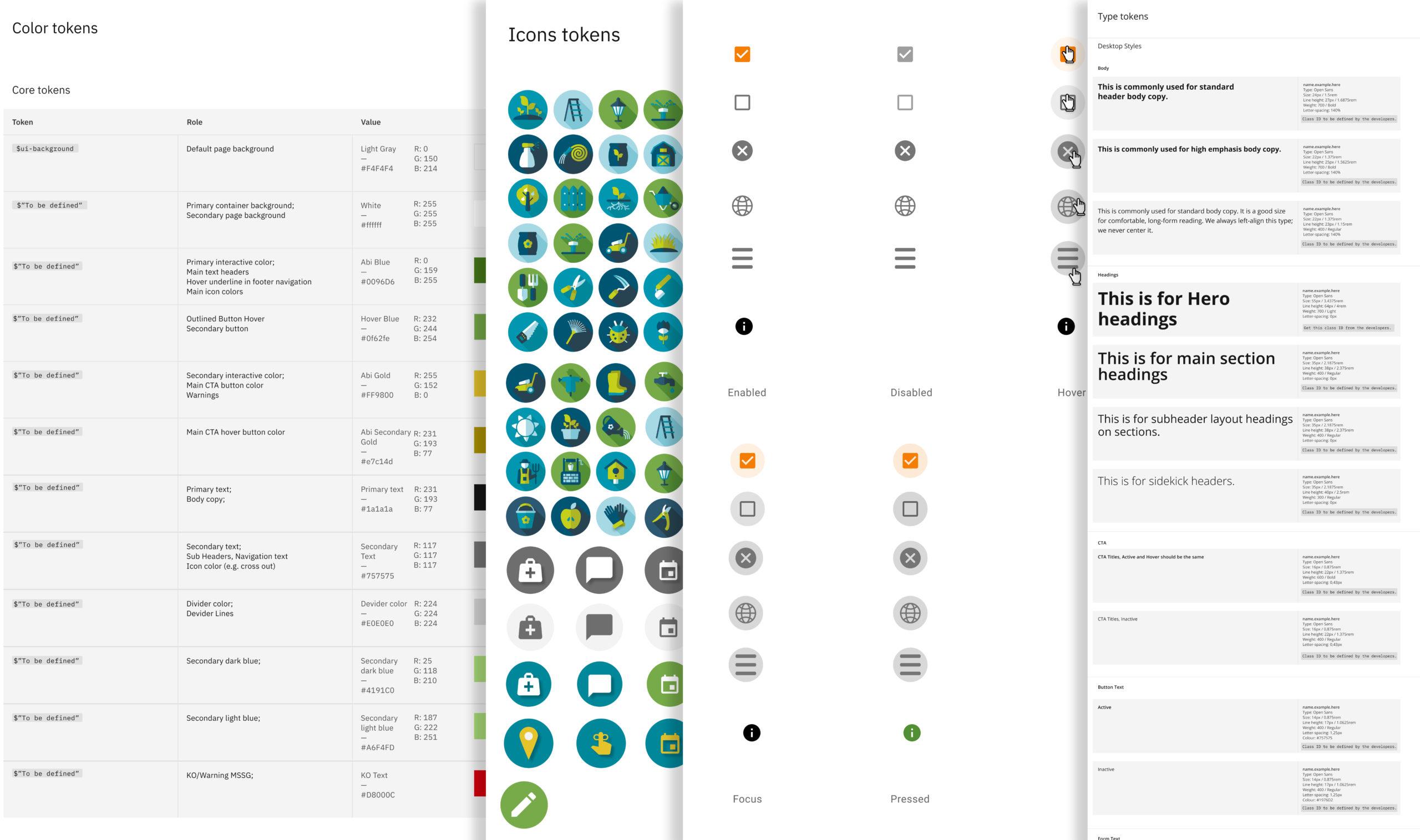
BRAND BOOK
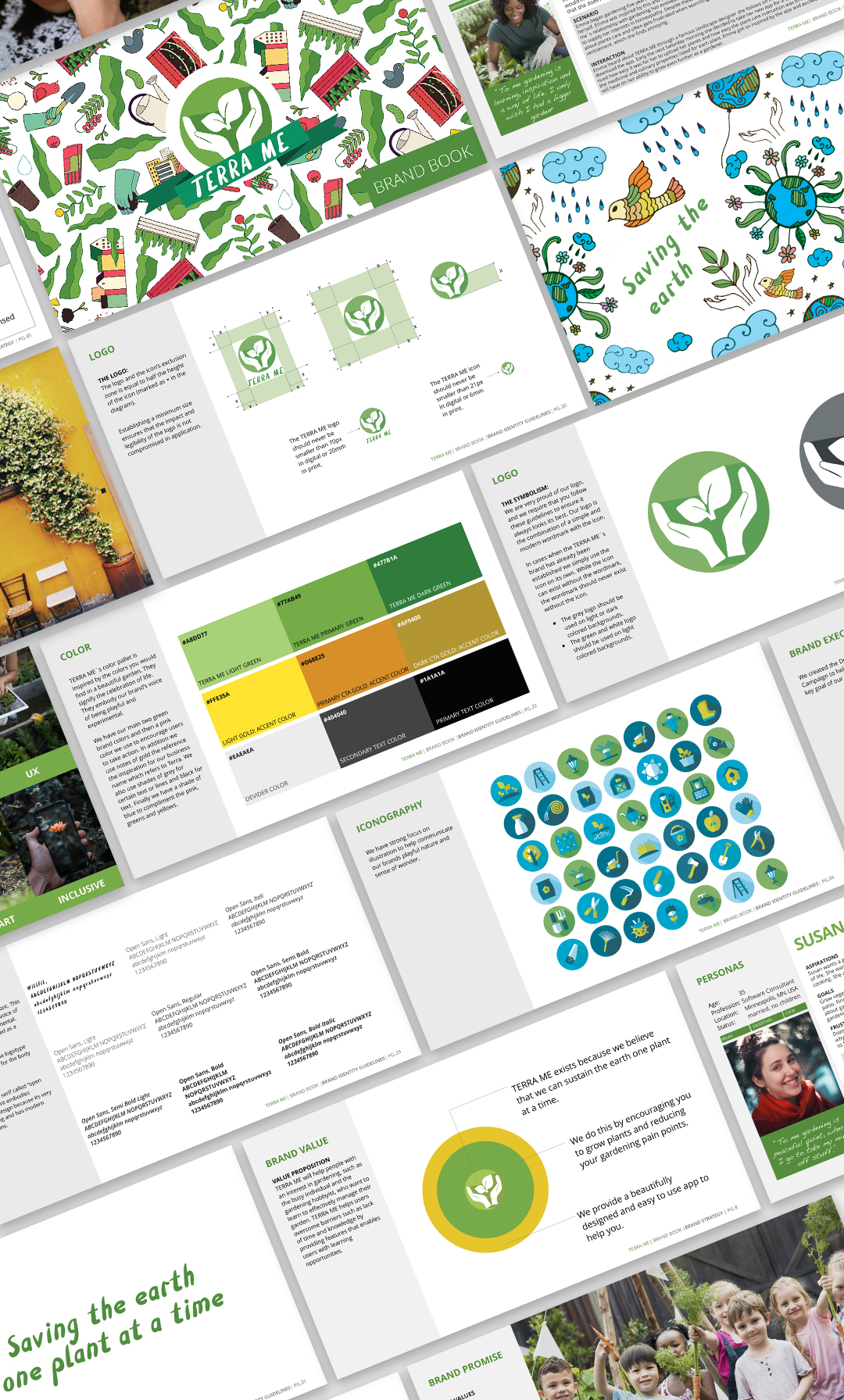
CONCLUSION
We created a final prototype that combines all features (Sign-In, Plant Search, Plant Profile, Water Reminder, Plant Doctor, and Community Forum) of TERRA ME. The design thinking methodology served us well as we developed TERRA ME. It was particularly useful in the ideation phase as we identified numerous solutions for TERRA ME. Yet it also kept us grounded, and helped us prioritize and focus on solving the main pain points identified by our users. We designed TERRA ME to help users find “one” platform with all the information, care, and management instructions needed to successfully grow plants. We hope that TERRA ME inspires users to overcome barriers, such as lack of time and knowledge, and delights our users as they accomplish their gardening goals.
Get In Touch
Liked what you saw and are curious to learn more, get in touch below.

